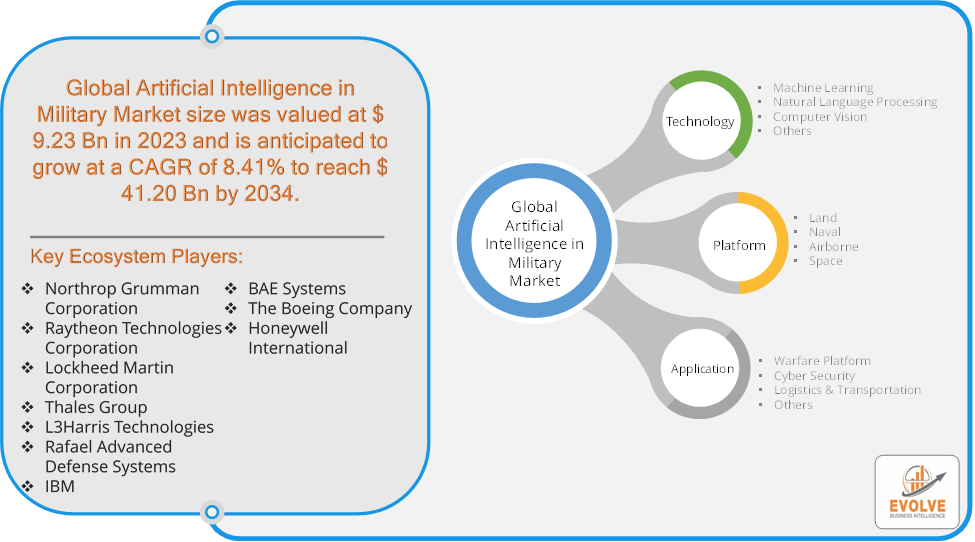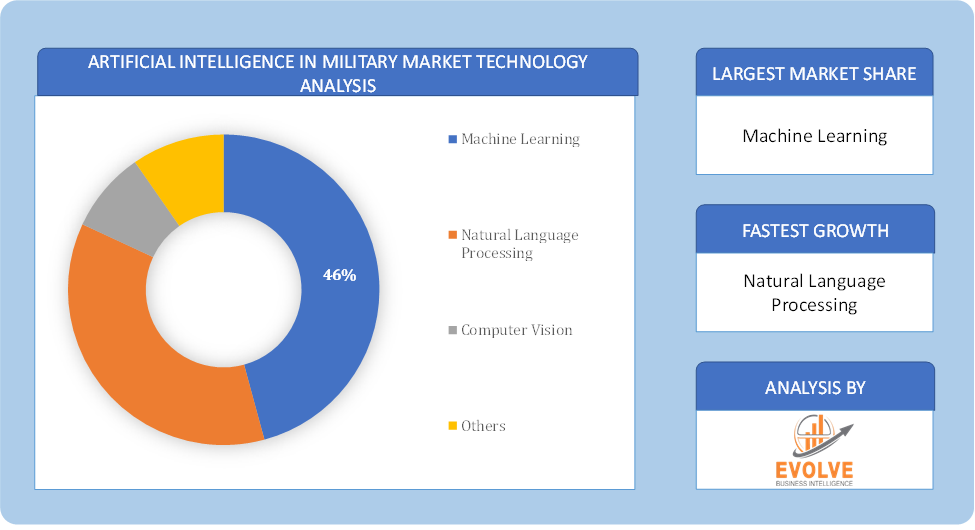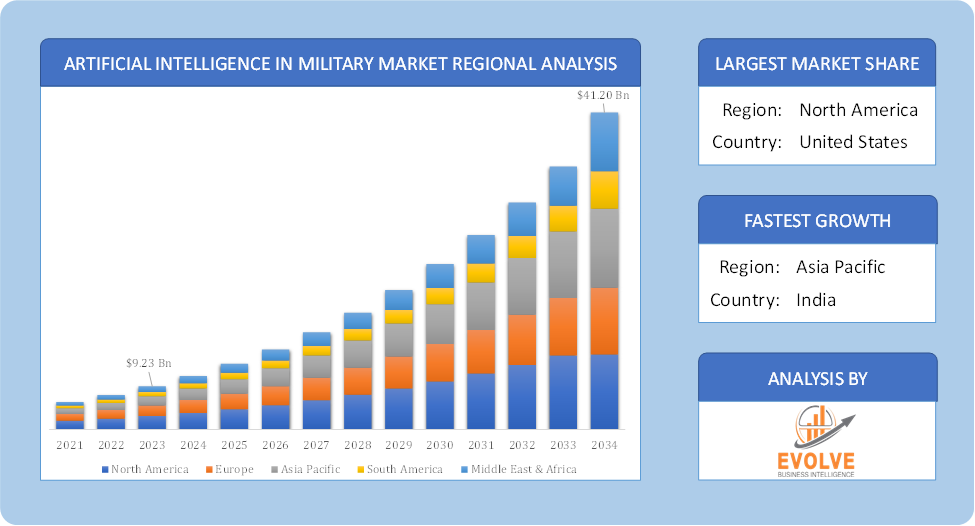Artificial Intelligence in Military Market Overview
The Artificial Intelligence in Military Market Size is expected to reach USD 41.20 Billion by 2034. The Artificial Intelligence in Military Market industry size accounted for USD 9.23 Billion in 2023 and is expected to expand at a compound annual growth rate (CAGR) of 8.41% from 2021 to 2034. The Artificial Intelligence (AI) in the Military Market refers to the application of AI technologies to various aspects of defense and military operations. This market encompasses a range of solutions and systems designed to enhance military capabilities through advanced data analysis, automation, and machine learning.
The AI in the Military Market is driven by the need for advanced technologies to maintain a strategic edge, improve operational efficiency, and enhance overall mission success.
Global Artificial Intelligence in Military Market Synopsis
 Artificial Intelligence in Military Market Dynamics
Artificial Intelligence in Military Market Dynamics
The major factors that have impacted the growth of Artificial Intelligence in Military Market are as follows:
Drivers:
Ø Technological Advancements
Rapid advancements in AI technologies, including machine learning, natural language processing, and computer vision, are making AI solutions more capable and accessible for military applications. The development and deployment of autonomous systems, such as drones and unmanned vehicles, are driving the need for AI to enable autonomous decision-making and improve mission effectiveness.
Restraint:
- Perception of Implementation Costs and Data Privacy Issues
The development and deployment of AI technologies in the military require significant financial investment. This includes costs for research and development, system integration, and ongoing maintenance. AI systems are susceptible to cybersecurity threats, including hacking and data breaches. Ensuring the security and integrity of AI systems is crucial to prevent malicious exploitation. The use of AI in military operations involves handling sensitive and classified information. Ensuring the privacy and protection of this data is critical and can be challenging.
Opportunity:
⮚ Enhanced Operational Efficiency
AI can streamline and optimize various military operations, such as logistics, maintenance, and resource management, leading to increased efficiency and reduced operational costs. AI-driven analytics can support better strategic and tactical decision-making by providing actionable insights and predictive models based on real-time and historical data. AI-powered simulations and virtual training environments can offer realistic and adaptive training scenarios for military personnel, improving readiness and performance.
Artificial Intelligence in Military Market Segment Overview
Based on Technology, the market is segmented based on Machine Learning, Natural Language Processing, Computer Vision and Others. The machine learning segment dominant the market. Machine learning revolutionizes military AI applications with precision and adaptability. ML’s diverse applications include threat detection and classification, forecasting security breaches, and anomaly detection for swift response. In image and object recognition, ML-driven computer vision aids surveillance. Natural Language Processing (NLP) enhances unstructured data analysis, while ML enables autonomy in vehicles and drones. From optimizing mission planning and supply chains to predictive maintenance, ML transforms logistics.
By Platform
Based on Platform, the market has been divided into Land, Naval, Airborne and Space. The space segment dominant the market. Space artificial intelligence involves numerous artificial satellites that serve as the backbone of various communication technology. The combination of AI and space platforms allows for effective communication between spacecraft and ground stations, which is anticipated to drive the expansion of artificial intelligence in the military market in future years.
By Application
Based on Application, the market has been divided into Warfare Platform, Cyber Security, Logistics & Transportation and Others. The cyber security segment dominant the market. Artificial intelligence significantly elevates military cybersecurity by employing advanced techniques. Through real-time threat detection, AI algorithms analyze extensive datasets, adapting to emerging vectors. Behavioral analysis monitors network activities for anomalies, while adaptive responses dynamically counter threats. Predictive analytics anticipates potential risks, bolstering proactive defense. AI-driven vulnerability management identifies and addresses system weaknesses, fortifying cybersecurity postures.
Global Artificial Intelligence in Military Market Regional Analysis
Based on region, the global Artificial Intelligence in Military Market has been divided into North America, Europe, Asia-Pacific, the Middle East & Africa, and Latin America. North America is projected to dominate the use of the Artificial Intelligence in Military Market followed by the Asia-Pacific and Europe regions.
 Artificial Intelligence in Military North America Market
Artificial Intelligence in Military North America Market
North America holds a dominant position in the Artificial Intelligence in Military Market. he U.S. is a major player in the AI military market, driven by substantial defense budgets and investments in cutting-edge technologies. The Pentagon’s initiatives, such as the Joint Artificial Intelligence Center (JAIC), focus on integrating AI across various defense applications, including autonomous systems, cybersecurity, and intelligence.
Artificial Intelligence in Military Asia-Pacific Market
The Asia-Pacific region has indeed emerged as the fastest-growing market for the Artificial Intelligence in Military Market industry. China is heavily investing in AI for military applications as part of its strategy to modernize its armed forces. Key areas include autonomous systems, advanced analytics, and military robotics and India is increasing its focus on AI in defense, with initiatives aimed at improving surveillance, reconnaissance, and cybersecurity. The Indian government is also fostering collaborations with technology firms to boost its AI capabilities.
Competitive Landscape
The global Artificial Intelligence in Military Market is highly competitive, with numerous players offering a wide range of software solutions. The competitive landscape is characterized by the presence of established companies, as well as emerging startups and niche players. To
Prominent Players:
- Northrop Grumman Corporation
- Raytheon Technologies Corporation
- Lockheed Martin Corporation
- Thales Group
- L3Harris Technologies
- Rafael Advanced Defense Systems
- IBM
- BAE Systems
- The Boeing Company
- Honeywell International
Key Development
In October 2022, Lockheed Martin and Red Hat, Inc. unveiled a partnership aimed at promoting artificial intelligence innovation. By embracing the recently introduced Red Hat Device Edge, Lockheed Martin aims to bolster U.S. national security initiatives. The collaboration focuses on the application and standardization of AI technologies in environments with geographical constraints, contributing to enhanced capabilities in critical operational areas.
Scope of the Report
Global Artificial Intelligence in Military Market, by Technology
- Machine Learning
- Natural Language Processing
- Computer Vision
- Others
Global Artificial Intelligence in Military Market, by Platform
- Land
- Naval
- Airborne
- Space
Global Artificial Intelligence in Military Market, by Application
- Warfare Platform
- Cyber Security
- Logistics & Transportation
- Others
Global Artificial Intelligence in Military Market, by Region
- North America
- US
- Canada
- Mexico
- Europe
- UK
- Germany
- France
- Italy
- Spain
- Benelux
- Nordic
- Rest of Europe
- Asia Pacific
- China
- Japan
- South Korea
- Indonesia
- Austalia
- Malaysia
- India
- Rest of Asia Pacific
- South America
- Brazil
- Argentina
- Rest of South America
- Middle East & Africa
- Saudi Arabia
- UAE
- Egypt
- South Africa
- Rest of Middle East & Africa
| Parameters | Indicators |
|---|---|
| Market Size | 2033: USD 41.20 Billion |
| CAGR (2023-2033) | 8.41% |
| Base year | 2022 |
| Forecast Period | 2023-2033 |
| Historical Data | 2021 (2017 to 2020 On Demand) |
| Report Coverage | Revenue Forecast, Competitive Landscape, Growth Factors, and Trends |
| Key Segmentations | Technology, Platform, Application |
| Geographies Covered | North America, Europe, Asia-Pacific, South America, Middle East, Africa |
| Key Vendors | Northrop Grumman Corporation, Raytheon Technologies Corporation, Lockheed Martin Corporation, Thales Group, L3Harris Technologies, Rafael Advanced Defense Systems, IBM, BAE Systems, The Boeing Company and Honeywell International |
| Key Market Opportunities | · Enhanced Operational Efficiency · Improved Decision-Making |
| Key Market Drivers | · Technological Advancements · Improved Data Analytics Capabilities |
REPORT CONTENT BRIEF:
- High-level analysis of the current and future Artificial Intelligence in Military Market trends and opportunities
- Detailed analysis of current market drivers, restraining factors, and opportunities in the future
- Artificial Intelligence in Military Market historical market size for the year 2021, and forecast from 2023 to 2033
- Artificial Intelligence in Military Market share analysis at each product level
- Competitor analysis with detailed insight into its product segment, Government & Defense strength, and strategies adopted.
- Identifies key strategies adopted including product launches and developments, mergers and acquisitions, joint ventures, collaborations, and partnerships as well as funding taken and investment done, among others.
- To identify and understand the various factors involved in the global Artificial Intelligence in Military Market affected by the pandemic
- To provide a detailed insight into the major companies operating in the market. The profiling will include the Government & Defense health of the company’s past 2-3 years with segmental and regional revenue breakup, product offering, recent developments, SWOT analysis, and key strategies.







